Complete destructive interference: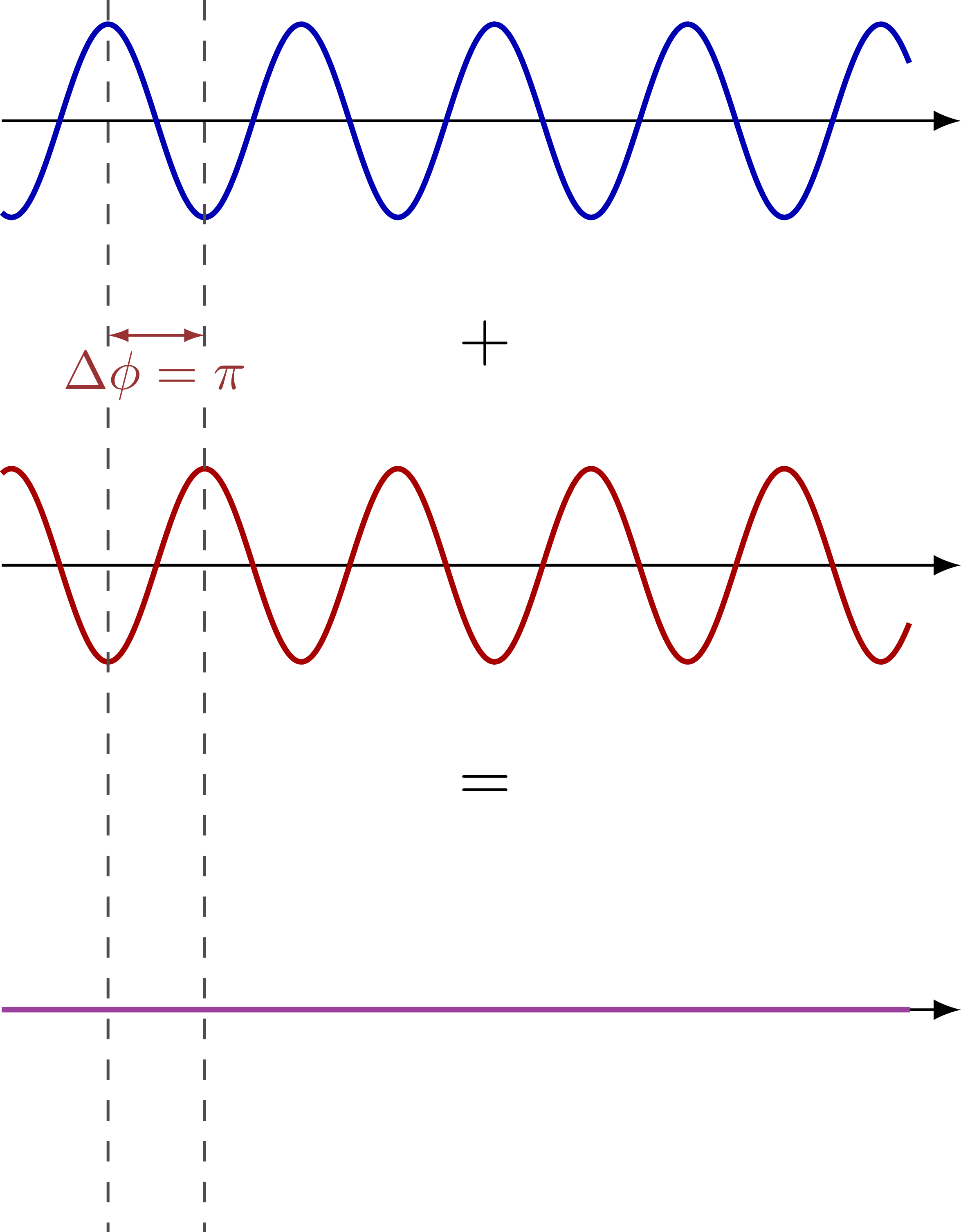 Partial destructive interference:
Partial destructive interference: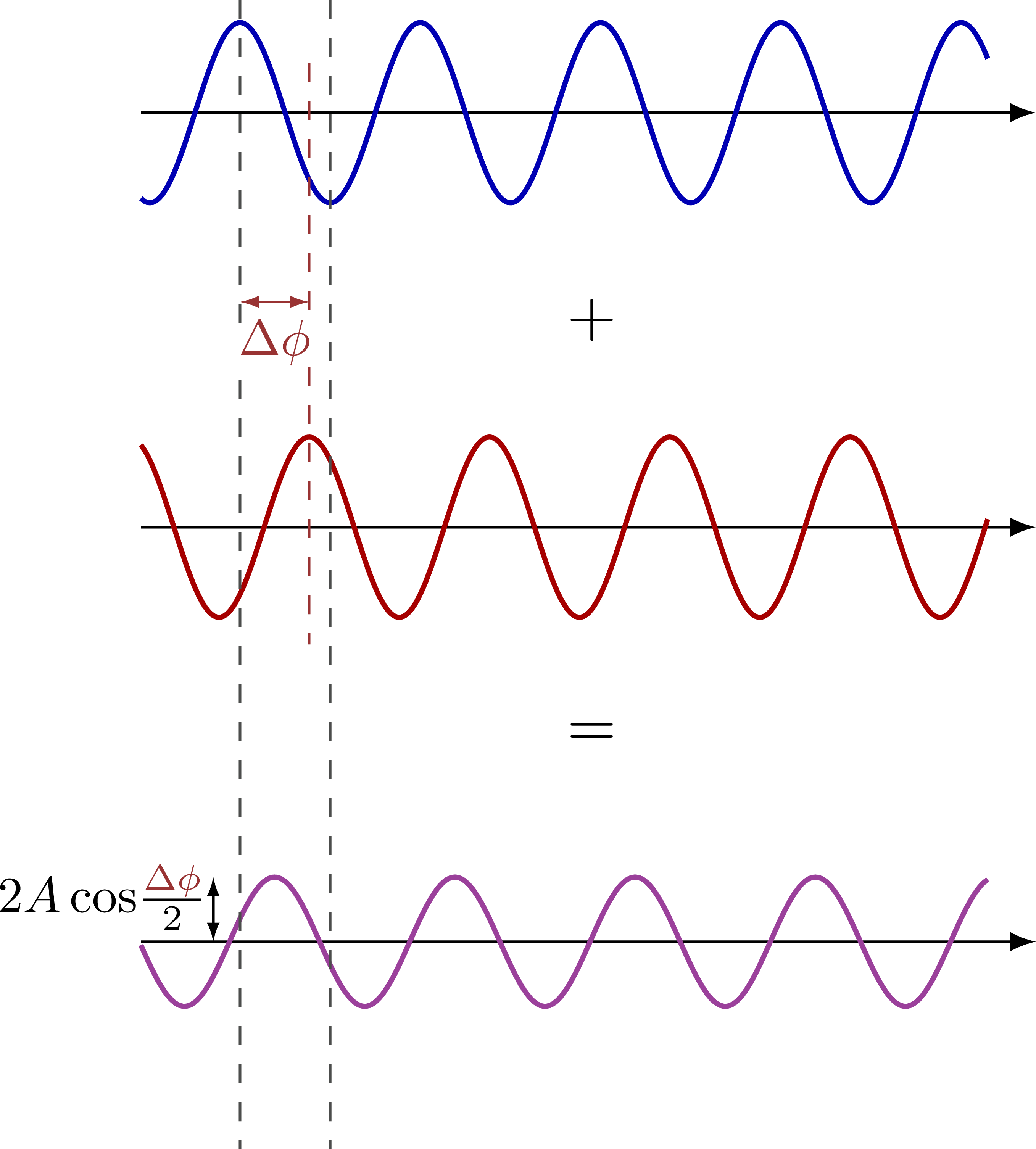 Complete constructive interference:
Complete constructive interference: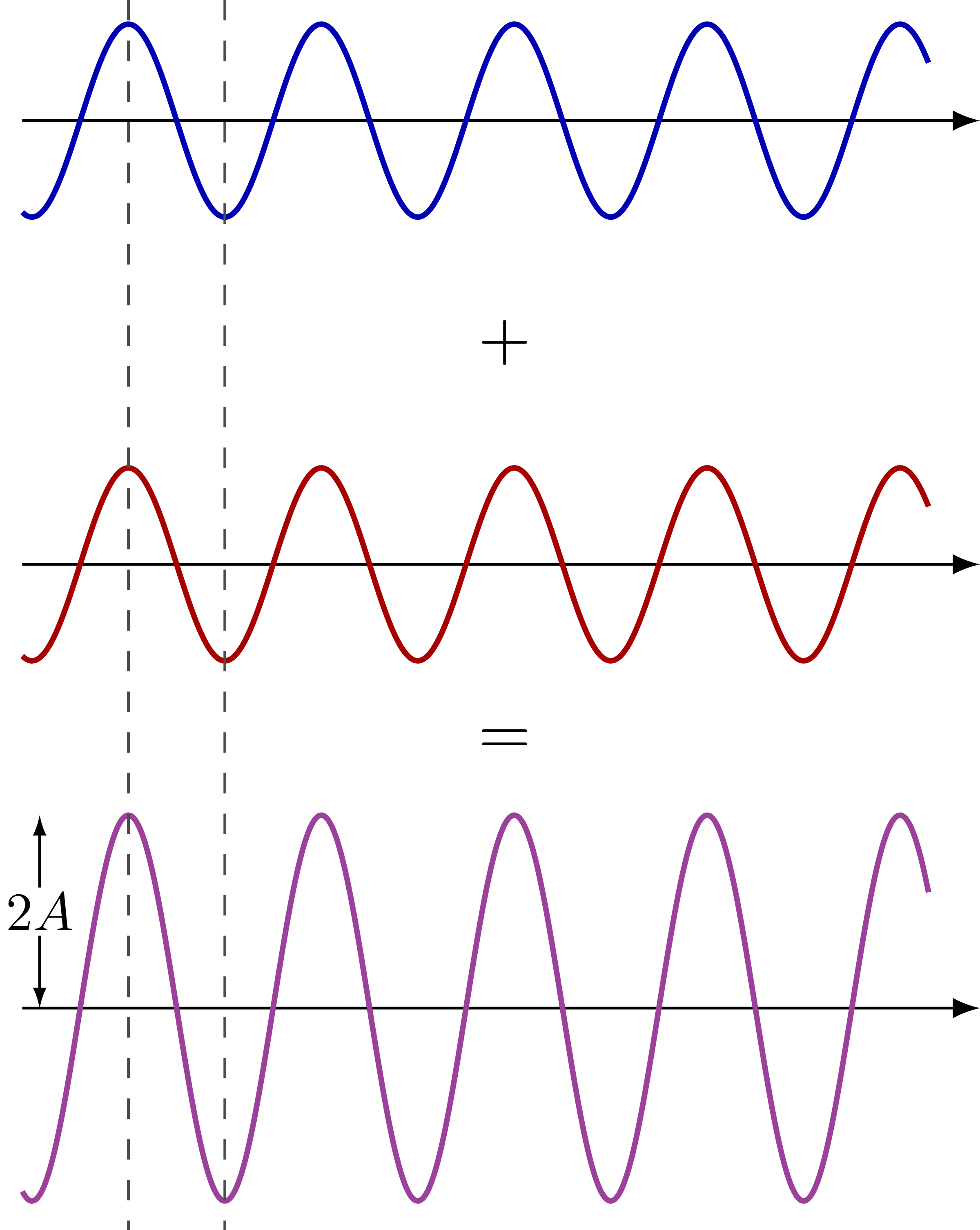 Interference pattern of two point sources in space:
Interference pattern of two point sources in space: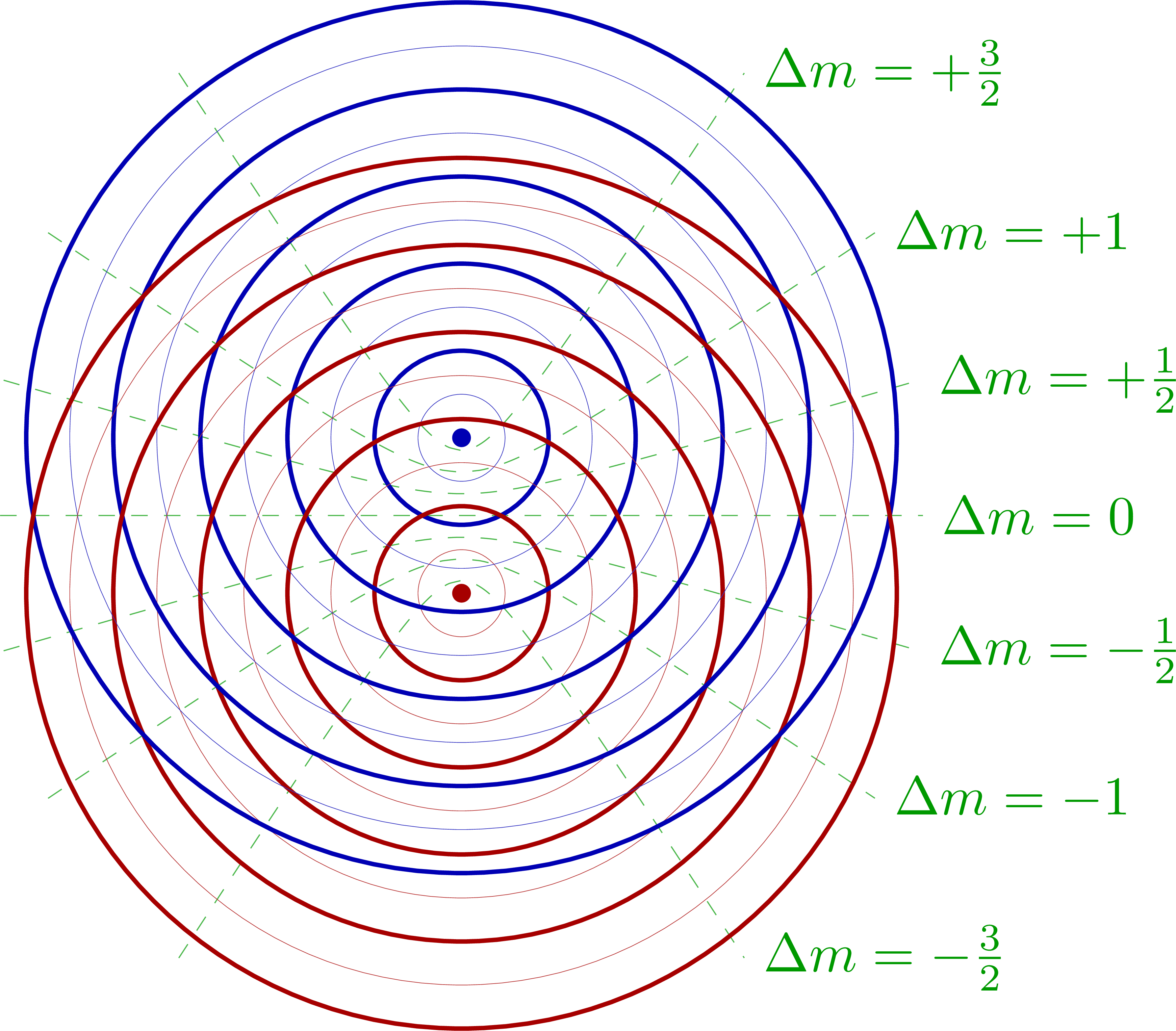 Path difference of the waves from two point sources:
Path difference of the waves from two point sources: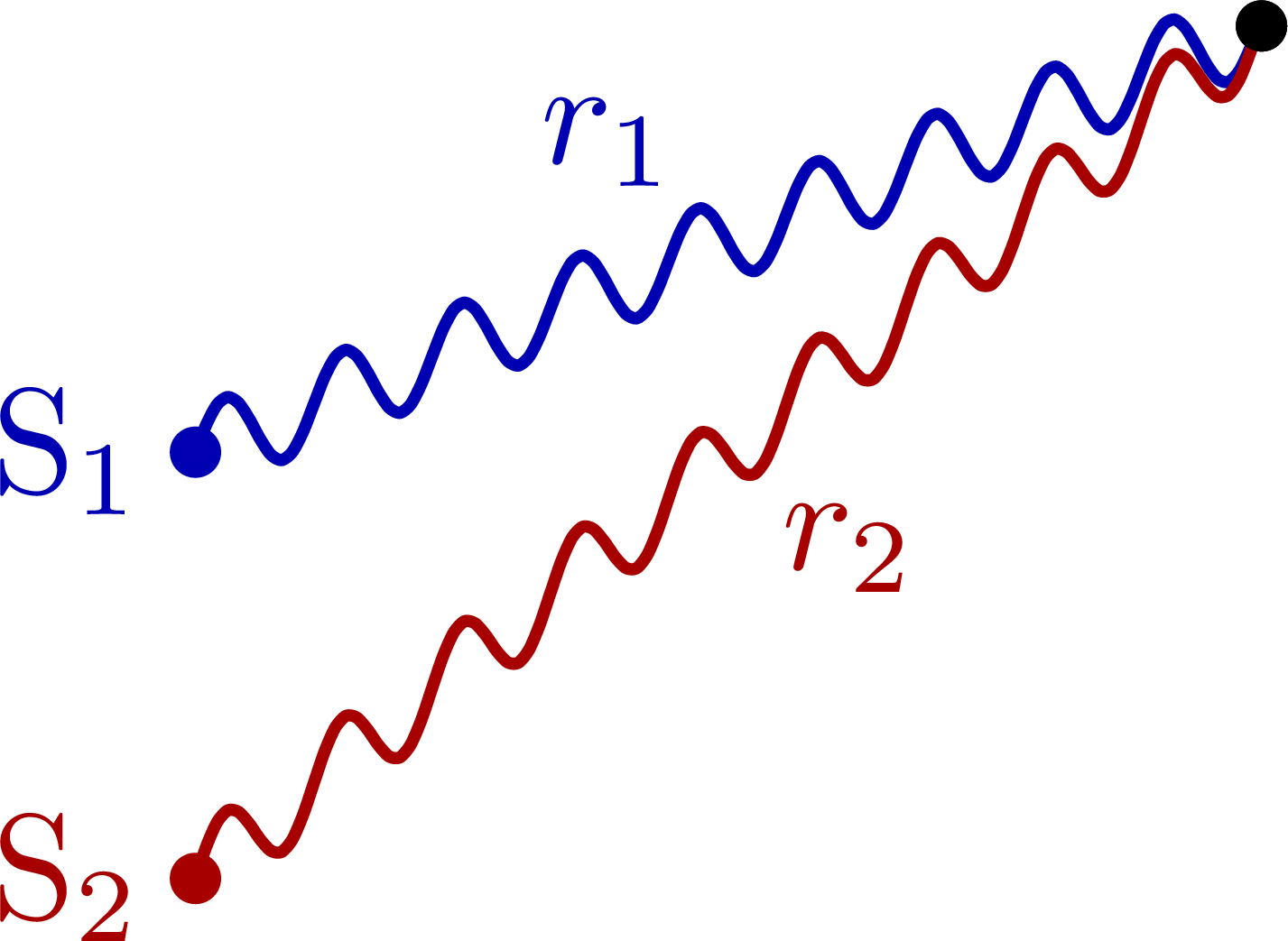
Click to download: optics_interference.tex • optics_interference.pdf
Open in Overleaf: optics_interference.tex
 Partial destructive interference:
Partial destructive interference: Complete constructive interference:
Complete constructive interference: Interference pattern of two point sources in space:
Interference pattern of two point sources in space: Path difference of the waves from two point sources:
Path difference of the waves from two point sources:
Edit and compile if you like:
% Author: Izaak Neutelings (June 2020)
% Inspiration: https://tex.stackexchange.com/questions/285578/how-to-draw-parallelepiped-and-cube-with-latex/288101#288101
\documentclass[border=3pt,tikz]{standalone}
\usepackage[outline]{contour} % glow around text
\usepackage{xcolor}
\usepackage{etoolbox} %ifthen
\usetikzlibrary{arrows,arrows.meta}
\usetikzlibrary{calc}
\usetikzlibrary{decorations.markings}
\usetikzlibrary{angles,quotes} % for pic (angle labels)
\tikzset{>=latex} % for LaTeX arrow head
\contourlength{1.6pt}
\colorlet{myblue}{blue!70!black}
\colorlet{myred}{red!65!black}
\colorlet{mypurple}{red!50!blue!95!black!75}
\colorlet{mylightgreen}{green!60!black!70}
\colorlet{mygreen}{green!60!black}
\colorlet{myredgrey}{red!50!black!80}
\tikzstyle{wave}=[myblue,thick]
\tikzstyle{mydashed}=[black!70,dashed,thin]
\tikzstyle{mymeas}=[{Latex[length=3,width=2]}-{Latex[length=3,width=2]},thin]
\begin{document}
% DESTRUCTIVE INTERFERENCE
\def\A{0.5}
\def\k{360}
\def\xmin{-0.3}
\def\xmax{4.4}
\def\h{2.3}
\def\lang{90}
\def\rang{270} % 720+270 = 990
\def\nsamples{200}
\begin{tikzpicture}
%\def\angg{asin(\na/\ng*sin(\anga))}
%\coordinate (O) at (0,0);
% WAVE 1
\draw[->,black]
(\xmin,0) -- (1.06*\xmax,0);
\draw[wave,variable=\x,samples=\nsamples,smooth,domain=\xmin:\xmax]
plot(\x,{\A*sin(\k*\x)});
\node at (\xmax/2,-\h/2) {$+$};
% WAVE 2
\begin{scope}[shift={(0,-\h)}]
\draw[->,black]
(\xmin,0) -- (1.06*\xmax,0);
\draw[wave,myred,variable=\x,samples=\nsamples,smooth,variable=\x,domain=\xmin:\xmax]
plot(\x,{\A*sin(\k*\x+180)});
\end{scope}
\node at (\xmax/2,-1.5*\h) {$=$};
% WAVE 3
\begin{scope}[shift={(0,-2*\h)}]
\draw[->,black]
(\xmin,0) -- (1.06*\xmax,0);
\draw[wave,mypurple]
(\xmin,0) -- (\xmax,0);
\end{scope}
% DASHED
\draw[mydashed]
(\lang/\k,1.25*\A) -- (\lang/\k,-2*\h-2.3*\A);
\draw[mydashed]
(\rang/\k,1.25*\A) -- (\rang/\k,-2*\h-2.3*\A);
\draw[mymeas,myredgrey]
(\lang/\k,-2.22*\A) --++ (180/\k,0)
node[pos=0.48,below=3pt,scale=0.8,inner sep=-1pt,fill=white]
{\contour{white}{$\Delta \phi=\pi$}};
\end{tikzpicture}
% PARTIAL INTERFERENCE
\begin{tikzpicture}
\def\dphi{138}
% WAVE 1
\draw[->,black]
(\xmin,0) -- (1.06*\xmax,0);
\draw[wave,variable=\x,samples=\nsamples,smooth,domain=\xmin:\xmax]
plot(\x,{\A*sin(\k*\x)});
\node at (\xmax/2,-\h/2) {$+$};
% WAVE 2
\begin{scope}[shift={(0,-\h)}]
\draw[->,black]
(\xmin,0) -- (1.06*\xmax,0);
\draw[wave,myred,variable=\x,samples=\nsamples,smooth,domain=\xmin:\xmax]
plot(\x,{\A*sin(\k*\x-\dphi)});
\end{scope}
\node at (\xmax/2,-1.5*\h) {$=$};
% WAVE 3
\begin{scope}[shift={(0,-2*\h)}]
\draw[->,black]
(\xmin,0) -- (1.06*\xmax,0);
\draw[wave,mypurple,variable=\x,samples=\nsamples,smooth,domain=\xmin:\xmax]
plot(\x,{2*cos(\dphi/2)*\A*sin(\k*\x-\dphi/2)});
\end{scope}
% DASHED
\draw[mydashed]
(\lang/\k,1.25*\A) -- (\lang/\k,-2*\h-2.3*\A);
\draw[mydashed]
(\rang/\k,1.25*\A) -- (\rang/\k,-2*\h-2.3*\A);
\draw[mydashed,myredgrey]
({(\lang+\dphi)/\k},0.55*\A) -- ({(\lang+\dphi)/\k},-\h-1.3*\A);
\draw[mymeas,myredgrey]
(\lang/\k,-2.1*\A) --++ (\dphi/\k,0)
node[midway,below,scale=0.8] {\contour{white}{$\Delta \phi$}};
\draw[mymeas]
(0.3*\xmin+\dphi/\k/2,-2*\h) --++ (0,{2*cos(\dphi/2)*\A})
node[inner sep=-3,scale=0.8,below=4,left=4] %fill=white
{$2A\cos\!\frac{\color{myredgrey}\Delta\phi}{2}$};
\end{tikzpicture}
% CONSTRUCTIVE INTERFERENCE
\begin{tikzpicture}
% WAVE 1
\draw[->,black]
(\xmin,0) -- (1.06*\xmax,0);
\draw[wave,variable=\x,samples=\nsamples,smooth,domain=\xmin:\xmax]
plot(\x,{\A*sin(\k*\x)});
\node at (\xmax/2,-\h/2) {$+$};
% WAVE 2
\begin{scope}[shift={(0,-\h)}]
\draw[->,black]
(\xmin,0) -- (1.06*\xmax,0);
\draw[wave,myred,variable=\x,samples=\nsamples,smooth,domain=\xmin:\xmax]
plot(\x,{\A*sin(\k*\x)});
\end{scope}
\node at (\xmax/2,-1.4*\h) {$=$};
% WAVE 3
\begin{scope}[shift={(0,-2*\h)}]
\draw[->,black]
(\xmin,0) -- (1.06*\xmax,0);
\draw[wave,mypurple,variable=\x,samples=\nsamples,smooth,domain=\xmin:\xmax]
plot(\x,{2*\A*sin(\k*\x)});
\end{scope}
% DASHED
\draw[mydashed]
(\lang/\k,1.25*\A) -- (\lang/\k,-2*\h-2.3*\A);
\draw[mydashed]
(\rang/\k,1.25*\A) -- (\rang/\k,-2*\h-2.3*\A);
\draw[mymeas]
(0.7*\xmin,-2*\h) --++ (0,2*\A)
node[fill=white,midway,inner sep=1,scale=0.8] {$2A$};
\end{tikzpicture}
% POINT SOURCES
\begin{tikzpicture}[
nodal/.style={mylightgreen,dashed,very thin},
declare function={
%xnode(\n,\dn,\lam,\f) = sqrt( (\n^2+(\n+\dn)^2)*\lambd^2/2 - (\n^2-(\n+\dn)^2)^2*\lambd^4/(4*\a^2) - \a^2/4 );
xnode(\n,\dn,\lam,\f) = \lam/\f*sqrt( \n^2*(\f^2-\dn^2)+\n*\dn*(\f^2-\dn^2)+\dn^2*\f^2/2-(\f^4+\dn^4)/4 );
ynode(\n,\dn,\lam,\a) = (2*\n*\dn+\dn^2)*\lam/(2*\f);
intensity(\y,\lam,\a,\L) = cos(180*\a*\y/(2*\lam*sqrt(\L*\L+\y*\y)))^2;
}
]
%\def\W{2.2}
%\def\H{2.2}
\def\N{10}
\def\lambd{0.28}
\def\R{\N*\lambd}
\def\a{1.0}
\def\Nlines{3}
\def\r{0.06}
%\def\nmax{10}
\def\nsamples{150}
% NODAL LINES
\draw[nodal]
(-1.06*\R,0) -- (1.06*\R,0) node[mygreen,right] {$\Delta m=0$};
% -1/2 + (1/0.44)/2 = 0.6363636364
% -2/2 + (1/0.44)/2 = 0.1363636364
% \c=int(\dn<int(\lambd))
%\begin{scope}
%\clip (-1.1*\W,-1.1*\H) rectangle (1.1*\W,1.1*\H);
%\clip (0,0) ellipse ({1.1*\R} and {(1.1*(\R-\a/2)});
%\clip (0,0) circle (1.1*\R);
\foreach \dn [evaluate={
\f=\a/\lambd;
\nmin=0.501*(-\dn+\f);
\nmax=1.06*\N;
\meven=int(\dn-1);
\c=int(\dn<\f);}
] in {1,...,\Nlines}{
\ifnum\c=1
\draw[nodal,variable=\n,samples=\nsamples,smooth]
plot[domain=\nmax:\nmin] ({-xnode(\n,\dn,\lambd,\f)},{ynode(\n,\dn,\lambd,\a)}) --
plot[domain=\nmin:\nmax] ({xnode(\n,\dn,\lambd,\f)},{ynode(\n,\dn,\lambd,\a)})
coordinate (+DN); %node[mygreen,right] {$\Delta m=\dn$};
\draw[nodal,variable=\n,samples=\nsamples,smooth]
plot[domain=\nmax:\nmin] ({-xnode(\n,\dn,\lambd,\f)},{-ynode(\n,\dn,\lambd,\a)}) --
plot[domain=\nmin:\nmax] ({xnode(\n,\dn,\lambd,\f)},{-ynode(\n,\dn,\lambd,\a)})
coordinate (-DN); %node[mygreen,right] {$\Delta m=-\dn$};
\ifodd\dn
\node[mygreen,right] at (-DN) {$\Delta m=-\frac{\dn}{2}$};
\node[mygreen,right] at (+DN) {$\Delta m=+\frac{\dn}{2}$};
\else
\node[mygreen,right] at (-DN) {$\Delta m=-\meven$};
\node[mygreen,right] at (+DN) {$\Delta m=+\meven$};
\fi
\fi
}
%\end{scope}
% WAVES
%\begin{scope}
%\clip (-\W,-\H) rectangle (\W,\H);
\foreach \i [evaluate={\R=\i*\lambd;}] in {1,...,\N}{
\ifodd\i
\draw[myblue!80,line width=0.1] (0,\a/2) circle (\R);
\draw[myred!80,line width=0.1] (0,-\a/2) circle (\R);
\else
\draw[myblue,line width=0.8] (0,\a/2) circle (\R);
\draw[myred,line width=0.8] (0,-\a/2) circle (\R);
\fi
}
%\end{scope}
% POINTS
\fill[myblue] (0,\a/2) circle (\r); %node[left] {\contour{white}{S$_1$}};
\fill[myred] (0,-\a/2) circle (\r); %node[left] {\contour{white}{S$_2$}};
\end{tikzpicture}
% PATH DIFFERENCE
\begin{tikzpicture}
\def\a{1}
\def\px{2.5}
\def\py{1.5}
\def\A{0.1}
\def\k{1300}
\def\r{0.06}
\coordinate (S1) at (0,\a/2);
\coordinate (S2) at (0,-\a/2);
\coordinate (P) at (\px,\py);
% WAVES
\draw[myblue,thick,samples=100,smooth,variable=\x,domain=0:1*\px]
plot(\x,{\a/2+(\py-\a/2)/\px*\x + \A*sin(\k*\x)});
\fill (\px,\py) circle (\r);
\draw[myred,thick,samples=100,smooth,variable=\x,domain=0:1*\px]
plot(\x,{-\a/2+(\py+\a/2)/\px*\x + \A*sin(\k*\x)});
\path (P) -- (S1) node[midway,above left,myblue] {$r_1$};
\path (P) -- (S2) node[midway,below right,myred] {$r_2$};
% POINTS
\fill[myblue] (0,\a/2) circle (\r) node[left] {S$_1$};
\fill[myred] (0,-\a/2) circle (\r) node[left] {S$_2$};
\fill (\px,\py) circle (\r);
\end{tikzpicture}
\end{document}Click to download: optics_interference.tex • optics_interference.pdf
Open in Overleaf: optics_interference.tex

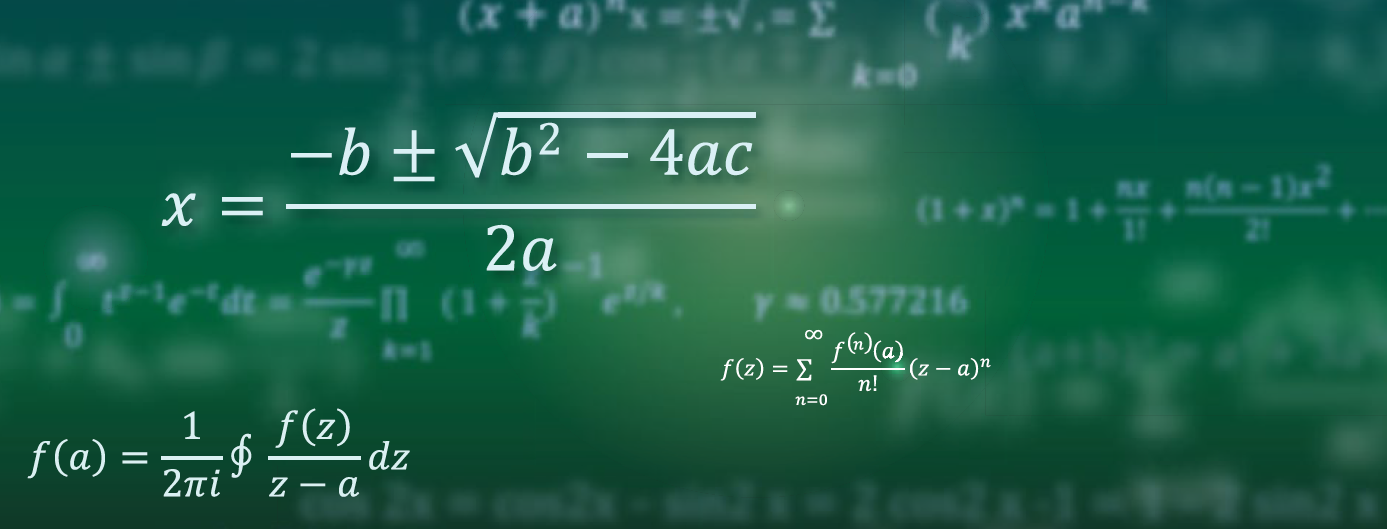



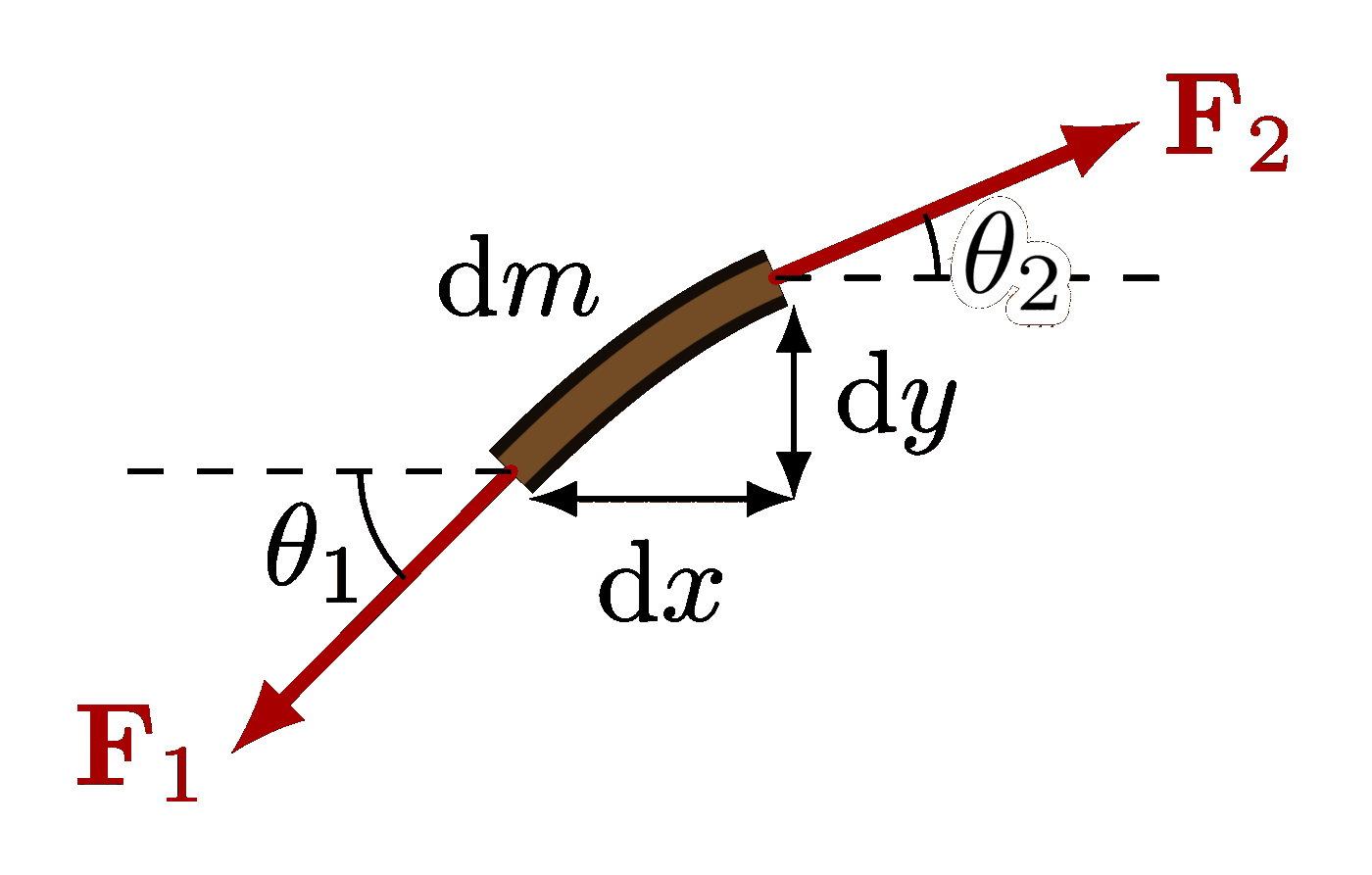
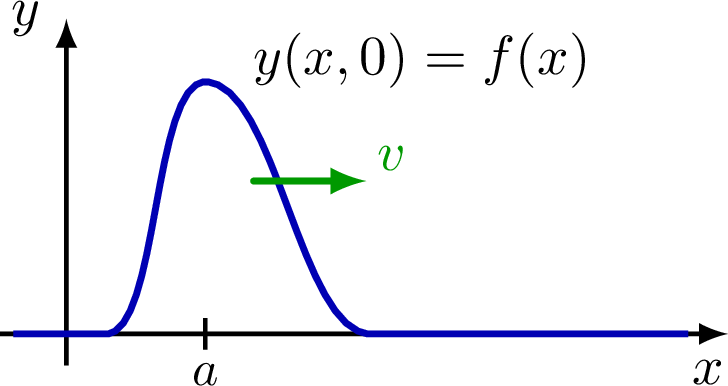

The code above seems to be incomplete. Thanks a lot for the great illustrations.
Hey Martin, Thanks for the heads up! It appears a ‘<' in the LaTeX code screwed up the HTML. It should be fixed now, but you can find the full file here: https://tikz.net/wp-content/uploads/2025/09/optics_interference.tex or open it in Overleaf via https://www.overleaf.com/docs?snip_uri=https://tikz.net/wp-content/uploads/2025/09/optics_interference.tex.
Cheers, Izaak
Thanks!
Really great diagrams, thanks for sharing. Just a small potential correction – shouldn’t the phase difference for complete destructive interference be pi radians (180 deg), not pi/2? Thanks again.
Hi Martin,
Unfortunately you are right… It should be fixed now!
Thank you for the correction.
Cheers,
Izaak